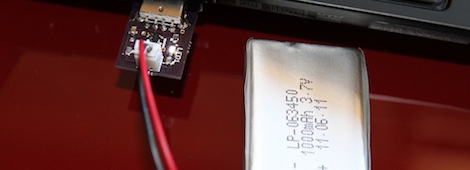As far as battery technology goes, Lithium Polymer cells are the bee’s knees. They’re powerful enough to handle very demanding applications and come in a multitude of sizes for any conceivable application. There’s a problem with LiPos, though – they have the tendency to explode when charged incorrectly. Luckily, [Paul] sent in a great tutorial on building a LiPo charger that works over USB.
In the original design of [Paul]’s board, he chose a Maxim MAX1551 Lithium battery charger. Confounded by the expense and/or unavailability of this IC (although Sparkfun has a few), he moved onto the similar Microchip MCP7813. This IC supports charging from a power source from 3.5 to 6 Volts as would be found in a USB hub.
The board [Paul] came up with is incredibly small – just barely larger than the USB plug itself. The layout is fairly simple as well. We’re thinking this could be a highly useful application of some home board fabrication. If you have a simpler way to charge LiPos that don’t require a specialized chip, send it into the tip line.
















